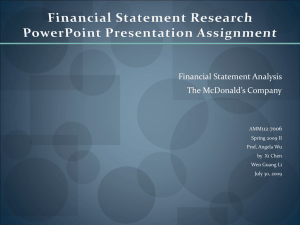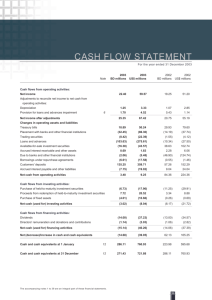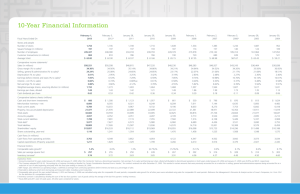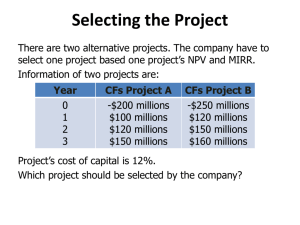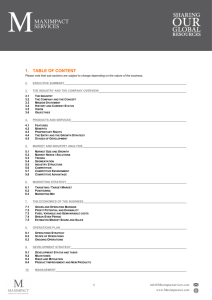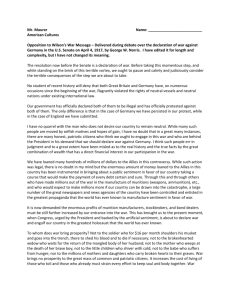1 - LaGuardia ePortfolio
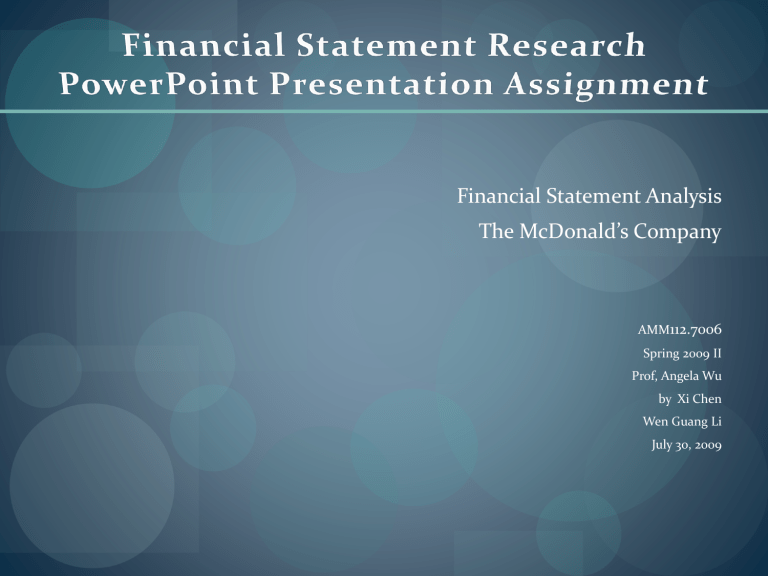
Financial Statement Analysis
The McDonald’s Company
AMM 112.7006
Spring 2009 II
Prof, Angela Wu by Xi Chen
Wen Guang Li
July 30, 2009
Company Summary
McDonald's Corporation is the world's largest chain of fast-food restaurants, primarily selling hamburgers, chicken, french fries, breakfasts and soft drinks. More recently, it also offers salads, fruit, snack wraps, and carrot sticks. The business began in 1940, with a restaurant opened by siblings Dick and Mac McDonald in San Bernardino, California. Their introduction of the "Speedee Service System" in 1948 established the principles of the modern fast-food restaurant. The present corporation dates its founding to the opening of a franchised restaurant by Ray Kroc, in Des Plaines, Illinois on April 15, 1955, the ninth McDonald's restaurant overall. Kroc later purchased the McDonald brothers' equity in the company and led its worldwide expansion. With the successful expansion of McDonald's into many international markets, the company has become a symbol of globalization and the spread of the American way of life. Its prominence has also made it a frequent subject of public debates about obesity, corporate ethics and consumer responsibility.
History & Overview
1950’s McDonalds Corporation was created. Followed by the opening of their 100 th restaurant in Chicago.
By 1970’s there are a McDonalds in every state
1980’s Followed its founder’s death, the McDonald Children’s Charity was created in memory of the founder.
As of that point, McDonalds have restaurants in more then 40 countries serving 20 million people a day.
Today McDonalds are practically in every major cities and countries around the world
Stock Performance - Chart
- McDonald’s - Nasdaq - Dow Jones - S&P 500
Income Statement
Year Ended December 31, All amounts in millions
Revenue
2008 2007 2006
23,522 22,787 21,586
Cost of Goods sold 14,883 9,819 14,602
Gross Profit 8,639 12,968 6,984
Administrative expenses 2,356 7,429 2,405
Non Recurring expenses (48) 1,775 134
Operating Income 6,332 3,763 4,445
Other Income/Expenses Net 238 103 123
Income before Interest and Taxes 6,681 3,982 4,568
Interest Expense 523 410 402
Income Before Tax 6,158 3,572 4,166
Income Tax Expense 1,845 1,237 1,293
Net Income from Continuing Ops 4,313 2,335 2,873
Discontinued Operations 60 671
Net Income 4,313 2,395 3,544
Income Statement
All amounts in Millions
25 000
20 000
15 000
10 000
5 000
0
Revenue Gross
Profit
Operating
Income
Income
Before
Taxes
Net
Income
2006
2007
2008
Growth analysis
(Horizontal analysis)
Year Ended December 31
Increase or (Decrease) Increase or (Decrease) among 2008 among 2007
2008 2007 2006 Amount Percent Amount Percent
Gross Profit 8,639 12,968 6,984 (4,328) (33.4%) 5,983 85.7%
Operating Income 6,332 3,763 4,445 2,568 68.3% (682) (15.3%)
Net Income 4,313 2,395 3,544 1,918 80.1% (1,149) (32.4%)
• Among 2008 : Gross Profit decreased 33.4% , Operating Income Increased 68.3%, Net Income increased 80.1%.
• Among 2007: Gross Profit increased 85.7%, Operating Income decreased 15.3%, Net Income decreased 32.4%.
• Overall, in 2008, even though gross profit decreases, operating income and net income were up substantially, and quality’s profit trend appears favorable; in 2007, even though gross profit increases, operating income and net income were down substantially, and quality’s profit appears unfavorable.
Margin Analysis
(Vertical analysis)
Year Ended December 31 All amounts in millions
2008 2007 2006
Amount Percent Amount Percent Amount Percent
Gross Margin 8,639 36.7% 12,968 56.9% 6,984 32.4%
Operating Margin 6,332 26.9% 3,763 16.5% 4,445 20.6%
Net Margin 4,313 18.3% 2,395 10.5% 3,544 16.4%
• Gross Margin increased 24.5% (56.9%-32.4%) from 2006 to 2007, but declined 20.2% (36.7%-
56.9%) from 2007 to 2008.
• Operating Margin declined 4.1% (16.5%-20.6%) from 2006 to 2007, but increased 10.4% (26.9%-
16.5%) from 2007 to 2008.
• Net Margin declined 5.9% (10.5%-16.4%) from 2006 to 2007, but increased 7.8% (18.3%-10.5%) from 2007 to 2008.
• Overall, even though gross margin increased from 2006 to 2007 and decreased from 2007 to
2008, operating margin and net margin decreased from 2006 to 2007 and increased from 2007 to
2008. Quality appeared to have improved from 2007 to 2008.
Balance Sheet
Year Ended December 31
All amounts in millions
Assets
Current Assets
Cash And Cash Equivalents
Net Receivables
Inventory
Other Current Assets
Total Current Assets
Long Term Investments
Property Plant and Equipment
Goodwill
Other Assets
Total Assets
2008 2007 2006
2,063
931
112
412
3,518
1,222
20,255
2,237
1,230
28,462
1,981
1,054
125
422
3,582
1,156
20,985
2,301
1,367
29,392
2,136
904
149
436
3,625
1,036
20,846
2,209
1,307
29,024
Balance Sheet
Year Ended December 31
All amounts in millions
Liabilities
Current Liabilities
Accounts Payable
Short/Current Long Term Debt
Other Current Liabilities
Total Current Liabilities
Capital Surplus
Other Stockholder Equity
Total Stockholder Equity
2008 2007 2006
2,506
32
-
2,538
4,600
101
13,383
3,634
865
-
4,499
Long Term Debt
Other Liabilities
Deferred Long Term Liability Charges
Total Liabilities
10,186
1,410
945
15,079
7,310
1,343
961
14,112
Stockholders' Equity
Common Stock 17
Retained Earnings
Treasury Stock
28,954
17
26,462
(20,289) (16,762)
4,227
1,337
15,280
17
25,846
(13,552)
3,445
(297)
15,458
2,739
18
251
3,008
8,417
1,075
1,067
13,566
Balance Sheet
All amounts in millions
35 000
30 000
25 000
20 000
15 000
10 000
5 000
0
Total
Current
Asset
Total Asset Total
Current
Liabilities
Total
Liabilities
Total
Stockholder
Equity
2006
2007
2008
Ratio Analysis –
Liquidity Ratios
Year Ended December 31 2008 2007 2006
Current Ratio 1.39:1 0.80:1 1.21:1
Acid-Test Ratio (Quick) 1.18:1 0.67:1 1.01:1
Receivables Turnover 1 23.70 times 23.28 times -
Inventory Turnover 125.70 times 71.59 times -
• From year 2006 to 2007, current ratio decreased, but from year 2007 to 2008 current ratio increased. Therefore, quality appeared to be fairly liquid.
• From year 2006 to 2007, Quick ratio decreased. Quick ratio seemed inadequate. From year
2007 to 2008, quick ratio increased and become more favorable.
• From year 2007 to 2008, receivable turnover increased a little, overall, it maintained high receivables turnover rate.
• From year 2007 to 2008, inventory turnover increased. It kept a very high inventory turnover rate . Generally, the faster the inventory turnover rate is, the less cash a company has tied up in inventory and the less the chance of inventory obsolescence.
Ratio Analysis –
Profitability and Solvency Ratios
Year Ended December 31, 2008 2007 2006
Profit Margin 18.34% 10.51% 16.42%
Return on Common Stockholder’ equity 30.10% 15.58% -
Debt to Total Asset Ratio 52.98% 48.01% 46.74%
• From year 2006 to 2007, profit margin decreased, from year 2007 to 2008, profit margin increased.
• From year 2007 to 2008, Return on common stockholder’ equity increased. Therefore, more dollars of net income the company earned for each dollar invested by the owners.
• From year 2006 to 2007, debt to total asset ratio increased, from year 2007 to 2008, debt to total asset ratio increased. Too higher debt to total ratio, the greater the risk that the company may be unable to meet its maturing obligations. Therefore, if the debt to total ratio keep increasing, it’s not good.
Statement of Cash Flows
Year Ended December 31,
Net Income
All amounts in millions
Operating Activities, Cash Flows Provided By or Used In
2008
4,313
2007
2,395
Depreciation
Adjustments To Net Income
1,208
150
Changes In Accounts Receivables 16
Changes In Liabilities 241
Changes In Inventories
Total Cash Flow From Operating Activities
Investing Activities, Cash Flows Provided By or Used In
Capital Expenditures
(11)
5,917
Investments
Other Cash flows from Investing Activities
Total Cash Flows From Investing Activities
Financing Activities, Cash Flows Provided By or Used In
1,214
1,303
(100)
94
(30)
4,876
(2,136) (1,947)
229 -
282 797
(1,625) (1,150)
Dividends Paid (1,823) (1,766)
Sale Purchase of Stock (3,371) (2,805)
Net Borrowings 1,046
Other Cash Flows from Financing Activities
573
34
(2,265)
2
Total Cash Flows From Financing Activities
Effect Of Exchange Rate Changes
Change In Cash and Cash Equivalents
(4,115)
(96)
$82
(3,996)
123
($147)
2006
3,544
1,250
(289)
(91)
(71)
(2)
4,342
(1,742)
-
467
(1,273)
(1,217)
(1,984)
273
(5,192)
-
($2,124)
Statement of Cash Flows
– Operating Activities
Year Ended December 31, All amounts in millions
Net Income
Depreciation
Adjustments To Net Income
Changes In Accounts Receivables
Changes In Liabilities
Changes In Inventories
Net cash Provided by Operating Activities
2008 2007 2006
4,313 2,395 3,544
1,208
150
1,214
1,303
1,250
(289)
16
241
(11)
5,917
(100) (91)
94 (71)
(30) (2)
4,876 4,341
• Cash inflow for operating activities increased 10.97% from year 2006 to 2007, and increased
21.35% from year 2007 to 2008.
• The increase from year 2007 to 2008 was mainly due to:
• Adjustments to net income increase $1,892 millions greater than the net income, which decreased $1,149 millions.
• The increase from year 2007 to 2008 was mainly due to:
• Net income increased $1,918 millions greater than the adjustments to net income which reduced $1,153 millions.
• Liabilities increased $147 millions
Statement of Cash Flows –
Investing Activities
Year Ended December 31, All amounts in millions
Capital Expenditures
Investments
Other Cash flows from Investing Activities
Net Cash Used by Investing Activities
2008 2007 2006
(2,136) (1,947) (1,742)
229 -
282
(1,625)
797 469
(1,150) (1,273)
• Cash outflow for investing activities decreased 9.94% from year 2006 to 2007, and increased
41.30% from year 2007 to 2008.
• The decrease from year 2006 to 2007 was mainly related to:
• Other cash flows from investing activities, cash inflow increased $328 millions greater than capital expenditures outflow which increased $205 millions.
• The increase from year 2007 to 2008 was mainly related to:
• Capital expenditures outflow increased $189 millions.
• Other cash flows from investing activities outflow increase $515 millions.
Statement of Cash Flows –
Financing Activities
Year Ended December 31, All amounts in millions
Dividends Paid
Sale Purchase of Stock
2008 2007 2006
(1,823) (1,766) (1,217)
(3,371) (2,805) (1,984)
Net Borrowings
Other Cash Flows from Financing Activities
1,046
34
573
2
(2,265)
273
Net Cash Used by Financing Activities (4,115) (3,996) (5,192)
• Cash outflow for financing activities decreased 23.04% from year 2006 to 2007 and increased 2.98% from year 2007 to 2008.
• The decrease from year 2006 to 2007 was mainly related to:
• Net Borrowings inflow increased $2,838 millions, greater than dividends paid and sale purchase of stock outflow that increased $1,370 millions.
• The increase from year 2007 to 2008 was mainly related to:
• Sale purchase of stock outflow increased $566 millions, greater than net borrowings inflow which increased $473 millions.
• Dividends paid outflow increased $57 millions.
Top Competitors
Burger king
YUM (KFC, Taco Bell, Pizza Hut)
Wendy’s
The most successful companies in the fast food industry are McDonald's,
Burger King and Yum (Pizza Hut, Taco Bell, KFC). Together these huge conglomerates dominate the industry, employing 3.7 million people worldwide; operating a combined total of 60,000 stores.
MCD Stock Vs. Major Competitors
- McDonald’s - Burger king -YUM Brands - Wendy’s
Back to Back Comparison
Market Cap:
Qtrly Rev Growth
Revenue :
Gross Margin :
EBITDA :
Oper Margins :
Net Income :
EPS :
P/E :
PEG:
P/S :
MCD
61.91B
-7.00%
22.56B
37.55%
7.39B
27.65%
4.25B
3.772
14.88
1.6
2.69
BKC YUM
2.29B 15.78B
1.00% -6.90%
2.55B
33.13%
454.00M
13.94%
10.90B
24.90%
2.02B
13.48%
192.00M
1.402
12.13
0.86
0.89
1.01B
2.094
16.15
1.35
1.46
Wen
2.05B
Industry
164.34M
185.30% 8.00%
2.38B
22.06%
410.61M
9.23%
310.35M 36.35M
3.76% 6.46%
(425.41M)
(1.512)
N/A
N/A
0.17
14.46
N/A 1.17
0.08 0.42
- McDonald’s - Burger king -YUM Brands - Wendy’s - Industry
Summary
After this financial statement analysis, we learn McDonald’s financial situation deeply.
McDonalds is the biggest fast-food franchise in the industry.
Its also the most profitable.
Though the company’s profits declined in 2007, but raised in 2008. most probably due to the down fall of economy that lead more consumer to buy cheaper food.
It’s a good company to invest in.
